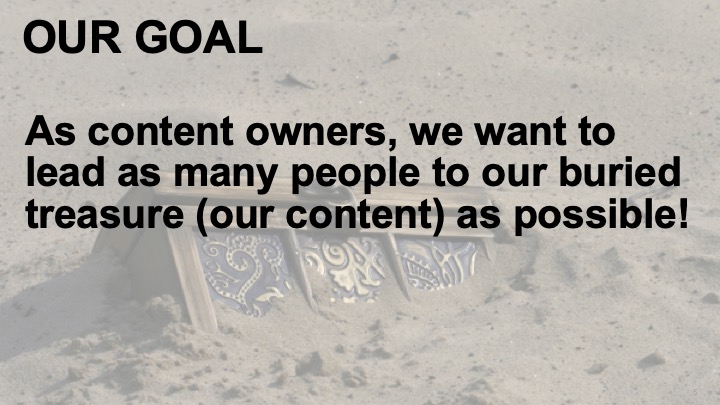You should. And here’s why I do.
I was tasked with enablement sessions for a brand-new tool created by our Enterprise Search team. This talented team has the impressive job of ensuring all of the millions of documents housed on our intranet are findable when searched for (think a smaller version of Google). No easy feat, but they’re delivered impressive results time after time.
Still with me?
This new, one-of-a-kind tool would allow content owners (people like me who own a site stocked with assets to help our people around the world work easier and more collaboratively) to understand how people were searching for their content and to help them ensure they’ve captured all the relevant keywords in their search engine optimization (SEO).
Um. What the heck did I just say?
Exactly. That was my concern when I was planning the enablement sessions to train people on the tool. I needed to figure out a way to explain what the tool did in a way that a global audience of content owners would understand. So, I told a story.
Storytelling is a tool rising in popularity in the enterprise. It’s the process of using fact and narrative to communicate something to your audience. Some stories are factual, and some are embellished or improvised in order to better explain the core message. Good stories connect with the audience’s emotions, allowing them an understanding based on familiar themes.
I needed a way to communicate exactly what this new tool did and—even more importantly—why the stakeholders would benefit from it. So, I pulled back from my close-up view of the tool and how to use It, then considered what it really was: a tool to help lead people to my content. My content became buried treasure (valuable and searched for) and this tool became something I could use to help draw a map to my content for those who seek it: explorers. My story was taking shape.
Why is story so effective in giving context for a concept like this? Stories are universal. Think, fairy tales or mythological stories. They’ve been around for centuries, spoken adult to child to entertain or to explain our place in the world. We speak in story daily. It’s when you use a metaphor or simile–any kind of analogy–to explain anything.
“The calm lake was a mirror.” Metaphor
“She was busy as a bee.” Simile
Pay attention during the day and you’ll be surprised how pervasive storytelling is in your daily life. It’s innate for us to use them to communicate feelings and experiences.
I’ll admit, I was a bit nervous to use storytelling to help explain how this new tool worked and how it would help our content owners, but after talking it over with a colleague who encouraged me to keep going, I’m so glad I did. I received some very positive feedback on this approach. I’ll definitely use it again.
Think about it. We are inundated with content every day at work and in our personal lives, so why not make the content we own as engaging—and memorable!—as possible.
Certainly, metrics, risks and benefits are necessary when we communicate in the corporate environment, but don’t be afraid to flex your creativity (within your audience’s comprehension). As a content consumer, we’re all looking for something told from a new perspective. Something that will catch our eye, capture our imagination, excite us. You’ll pleasantly surprise your audience, and you may surprise yourself, too.
Recommended Reading
Next post: Spice Up Your Content with Video













One thought on “Do You Tell Stories at Work?”